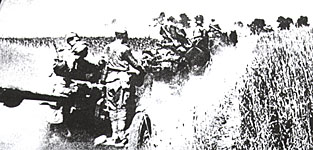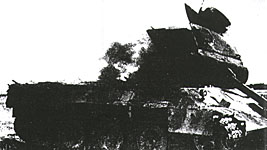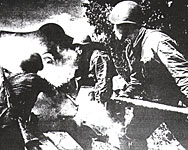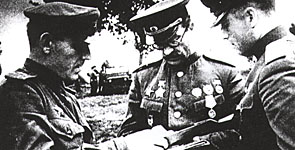"This attack is of decisive importance. It must succeed, and it must do so rapidly and convincingly. It must secure for us the initiative for this spring and summer. The victory of Kursk must be a blazing torch to the world."
The Red Army had rushed westward after its victory at Stalingrad, but by the spring thaw, its offensive capabilities were spent - both armies were stuck fast in the mud. A remnant of the advance was a huge salient in the line in the area of Kursk. As the armies gathered their strength int he months that followed, the strategic attention of both was drawn to that area, attracting the metal-shod armies like a lodestone for the great showdown of the war. The adversaries had by then reached a delicate equilibrium; the initiative of the war lay on the wet Russian earth between them. The ultimate victor in this war would be the army that held it when the battle ended.
As the German Army repaired its losses, Hitler became increasingly hungry for a great victory to sustain the morale of Germany and its allies. Increased production, new tanks and manpower replacements would give the German Army the capability to fight one more great offensive battle. Thereafter German strength could only decline. That battle then had to be a victory of great proportions, and Kursk was identified as the most promising opportunity. Hitler initially set the date for the attack, code-named 'Zitadelle', in May but repeatedly postponed it until war production could supply enough of the new heavy Tiger, Panther and Ferdinand (Elefant) tanks. Arguments to go over to the defensive and bleed the Red Army to death fell on deaf ears. Like a spendthrift with money in his pocket, Hitler could not assemble a reserve without using it at the first opportunity.
The Soviet High Command had also foreseen a great showdown battle, but Stalin proved a more patient and subtle war leader. He accepted the advice of the General Staff and his major commanders in early April to ride out he first German attack and then go over to a counter-offensive that would drive the enemy out of the Motherland. It was the best of both worlds. The Red Army would have qualitative superiority in equipment and numbers, and it would have the initial advantage of the defence. Its operational capabilities had also dramatically improved; a winning team of capable and even brilliant commanders had been sifted through the first two hard years of the war. In addition, the Red Army was benefiting from unsurpassed strategic Intelligence. Churchill sent Ultra intercepts directly to Stalin. Agents in a huge underground network fed the Soviets minute details on German troop movements, industrial production and foreign policy that allowed them to calculate the German war effort with great precision.
The German plan was to pinch off the Kursk salient with a great double envelopment from the north and south. Army Group Centre (Field Marshal von Kluge) would attack south from the direction of Orel with Fourth Army and elements of Second Army. At the same time, Field Marshal von Manstrin's Army Group South would attack north from the direction of Belgorod with Fourth Panzer Army and Armeeabteilung 'Kempf'. The two forces would meet in the rear of the salient at the city of Kursk. Fifty divisions, including sixteen panzer and panzer grenadier divisions were concentrated in the area of the salient of which 39 would be used in the attack. This force numbered 900,000 men, 2,700 tanks and SP guns, 10,000 guns and mortars, and 2,000 combat aircraft. Hitler was gambling everything on the battle - these forces represented 70 per cent of panzer divisions, 30 per cent of panzer grenadier divisions, and 65 per cent of combat aircraft in the east.
The Red Army had been assembling an even mightier host, 40 per cent of its entire operational forces. The Central (Army General Rokossovsky) and Voronezh (Army General Vatutin) Fronts which occupied the northern and southern halves of the salient would total 1,336,000 men, 3,444 tanks and SP guns, 19,100 guns and mortars, and 2,172 combat aircraft. On Vatutin's southern flank was Army General Konev's Steppe Front with another 553,000 men, 7,401 guns and mortars, and 1,551 tanks and assault guns - held back for the great counter-offensive. To the north of Rokossovsky's Front were Bryansk (Army General Popov) and Western (Army General Sokolovsky) Fronts. Behind the first echelon were stacked powerful additional reserves of the High Command that included several armies, two tank armies and one air army.
Not only were vast forces assembled, but their combat power was steadily improved. Manoeuvre forces were reinforced with artillery, anti-tank and mortar units. Rifle divisions were re-equipped with modern automatic and anti-tank weapons and combined into rifle corps to improve command and control. New artillery formations were created and armed with improved model weapons. High Command artillery reserves, consisting of breach brigades, divisions, and corps were formed to create a high fire density on the main sectors.
By that summer five tank armies had been created, consisting of two tank and one mechanized corps. Each Front was allotted anti-aircraft divisions and its own air army of 700 to 800 aircraft of new types. Logistics support reached a degree of sophistication and equipment hitherto unseen as Soviet industry and Lend Lease in the form of tens of thousands of Studebaker trucks delivered huge quantities of supplies to the theatre. Within the salient itself, the Red Army was preparing for the German attack by transforming the area into one vast network of field fortifications and minefields.
For the first time in the war the Soviets were able to construct three defensive belts to a depth of 60 kilometres within which they sited anti-tank weapons and strongpoints, employing direct and indirect artillery fire, mobile obstacle construction detachments, as well as tanks and assault guns. The Germans would be attacking a fortress consisting of 5,000 kilometres of trenches strewn with 400,000 mines. On the main breakthrough sector of Central Front, 112 kilometres of barbed wire were laid, 10.7 kilometres of which were electrified. Adding to the effectiveness of the defensive works was the masterful job of camouflage which hid much of it from the Germans.
Soviet Intelligence had pinpointed the timing of the German offensive to the early morning of 5 July. Zhukov acted swiftly to get in the first punch. He described the moment when 'he' began the Battle of Kursk:
'At 2.20 am the order was issued to begin the counter-preparation. Everyone raced round and round, twisting and twirling, a terrible rumbling was heard and a very great battle in the Kursk area began. The sounds of the heavy artillery, the explosion of bombs and the M-31 rocket projectiles, the outbursts of the Katyushas and the constant hum of aircraft engines into what was like the strains of a "symphony" from Hell.'
The artillery counter-preparation of both Fronts struck barely two hours before the Germans attacked, catching the infantry in their assembly areas and savaging the German artillery. At dawn the Red Air Force struck at the German airfields, but the Luftwaffe was already in the air. The Germans attacked on schedule, but their command and control had been disrupted and they had taken heavy casualties before firing a shot.
Fourth Army attacked Central Front's 13th, 48th and 70th Armies, the brunt being borne by the 13th. The Germans steadily ground through the mesh of stoutly defended positions at great loss. Whole units were consumed in the fighting - Captain Igishev's anti-tank battery of 13th Army died to a man but took nineteen German tanks with them. In the northern part of his Front's sector Rokossovksiy was forced to bury some of his tanks as pillboxes with orders to fire only on infantry and armoured personnel-carriers. His tank units had been hurling themselves on the heavier Tiger and Panthers and had been badly cut up. This new tactic stripped the panzers of their infantry support and held them up for four days.
By the 7th, von Kluge's corps had gouged a 10-kilometre wedge into the defences in the direction of Ponryi where they were halted by the firepower of 307th Rifle Division, reinforced by 5th Artillery Division, 13th Anti- tank Brigade, and 1lth and 22nd Mortar Brigades. By the 8th the Germans were still attacking, and Rokossovsky committed his entire reserve. It was then that the great counter-stroke was set in motion. Bryansk and part of the Western Fronts attacked to the north of Central Front on 12 July. Code-named 'Kutuzov' this counter-stroke in the direction of Orel took the Germans completely by surprise and made good headway. Almost immediately the pressure on Central Front was relieved as Army Group Centre drew divisions away from the Kursk salient to counter 'Kutuzov'. On the 15th Central Front also went over to the offensive.
To the south against Voronezh Front ,he Germans under the redoubtable von Manstein were having better luck. Two panzer corps struck the main blow at General-Lieutenant Chistykov's 6thGuards Army supported by 1st Tank Army. By the end of the day they had penetrated 20 kilometres, crushing 52nd Guards Rifle Division and brushing aside 67th Guards, whose commander was to write:
By the end of the 6th, Vatutin's Front had been badly hurt. The second defensive line had been pierced in the sector of 6th Guards Army; the Soviet High Command then released the hard core of its reserves, 5th Guards Tank Army commanded by Lieutenant-General Rotmistrov. But 5th Guards was 300 kilometres to the south, and it would take almost three days to reach Voronezh Front. On the 7th and 8th the situation reached crisis point for Vatutin. His 1st Tank Army had been badly mauled and 6th Guards Army was on its last legs. 1st Tank Army Commander, Lieutenant-General Katukov, watched the Germans approaching across a narrow scorched field and said, 'They are regrouping ... advancing in a spearhead ... I think we have had it.'
By the 9th, von Manstein had achieved a 35-kilometre breakthrough in the direction of Oboyan while Abeilung 'Kempf' Army had a 10-kilometre penetration to the south towards Korocha. The Front was barely saved from collapse by the intervention of heavy corps from Steppe Front. By the 11th the situation had worsened. In desperation Vatutin ordered Katukov's battered 1st Tank Army to dig in its tanks with those of Chistyakov's equally wounded 6th Guards Army to reinforce the defence. The Germans continued to press Vatutin's defences toward Prokhorovka in the north and towards Rzhavets to the south. Voronezh Front was unravelling in Vatutin's hands. Then Rotmistrov's 5th Guards Tank Army arrived.
Rotmistrov had arrived only to be presented with a crisis even worse than he had expected. Rotmistrov:
Table of Contents
Published by Greenhill Books. © Greenhill Books. All rights reserved. Reproduced on MagWeb with permission of the publisher.
Magazine articles and contents are copyrighted property of the respective publication. All copyrights, trademarks, and other rights are held by the respective magazines, companies, and/or licensors, with all rights reserved. MagWeb, its contents, and HTML coding are © Copyright 1998 by Coalition Web, Inc. This article appears in MagWeb (Magazine Web) on the Internet World Wide Web.
Right: Soviet horse-drawn 76mm anti-tank guns moving into a new position on the Voronezh Front during the Battle of Kursk, July 1943. Soviet Intelligence had pinpointed the German attack as starting on 5 July. Prisoner interrogations on 4 July elicited the very hour of the attack.

Right: A burning German Panther Mark V hit by Soviet artillery on the Central Front during the Battle of Kursk, July 1943.
 Right: Rokossovsky's defences were particularly tough for Ninth Army to penetrate. Its initial assault ground to a halt against the village of Ponryi defended by 307th Rifle Division massively reinforced with artillery. General of Panzer Troops Lemelsen, commander of XLVII Panzer Corps described the problem. Here it must be pointed out once again that the Russians were masters of camouflage. Neither mine fields nor anti-tank weapons could be detected anywhere before the time the first tank had moved into the minefield or the first Russian gun unexpectedly opened fire.
Right: Rokossovsky's defences were particularly tough for Ninth Army to penetrate. Its initial assault ground to a halt against the village of Ponryi defended by 307th Rifle Division massively reinforced with artillery. General of Panzer Troops Lemelsen, commander of XLVII Panzer Corps described the problem. Here it must be pointed out once again that the Russians were masters of camouflage. Neither mine fields nor anti-tank weapons could be detected anywhere before the time the first tank had moved into the minefield or the first Russian gun unexpectedly opened fire.
'... the German infantry bypassed our emplacements and infiltrated between the batteries. The tenacity of the Fascists bordered on insanity. They fought to break through our defences ... no matter what the losses. The infantry at our first echelon was routed and the artillery regiments were smashed. The remaining infantry elements retreated to the north. All that was left at the emplacements were wrecked guns and dead soldiers.'
'On the evening of 11 July, German formations reached the area immediately in front of Prokhorovka. My previous decision to mount a counterattack could not be carried out under these circumstances. Because of the withdrawal of me formations to Prokhorovka, the two-day-long artillery preparatory fire supporting the counter-attack of Fifth Guards Tank Army had to be interrupted and new assembly areas had to be designated. Missions for our troops had to be changed and discussed again. The capture of Prokhorovka on 11 July forced me to commit two tank brigades west of Prokhorovka that evening to halt the enemy attack. The army had to be prepared for our counter-attack all over again. There were only ten hours to do this; only three were left after daybreak. Under these circumstances the troops' combat preparations had to suffer. The corps and brigade commanders had no time to reconnoitre their new assembly areas and to designate the line of their main effort.'

Right: On the night of the 11th, the 5th Guards Tank Army arrived in the rear of the dying Voronezh Front. The 5th Guards consisted of XVIII and XIX Guards Tank and V Guards Mechanized Corps. They were further reinforced with II Guards Tank Corps and II Tank Corps. This host was commanded by Lieutenant-General of Tank Troops Pavel A. Rotmistrov, shown here at a forward headquarters. Rotmistrov's plan for the counter-attack became useless when the Germans overran his planned staging areas at Prokhorovka on 11 July. He had to commit two brigades immediately to prevent a German breakthrough. Then he had ten hours left to prepare his army for the decisive action of the war.
The Greatest Battle in History: Kursk - 1943, Part 2
Back to List of One-Drous Chapters: World War II
Back to List of All One-Drous Chapters
Back to MagWeb Master Magazine List
Other military history articles and gaming articles are available at http://www.magweb.com